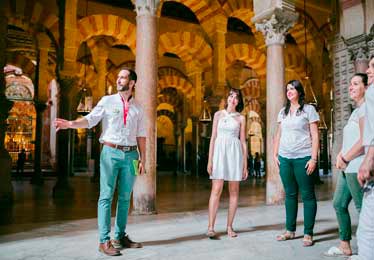Cordoba was the capital of the Roman province ( Provincia Hispania Ulterior Baetica ), the most splendid period, when it had so many buildings dedicated to joyful matters as Rome, to which it gave a lot of philosophers like Lucio Anneo Séneca , orators like Marco Anneo Séneca and poets like Lucano . Afterwards, it occupied an important place in the Spania province of the Byzantine Empire and during the Visigoth period. It managed to regain the status of Capital during the Independent Emirate and the Western Omeya Caliphate. In this period it reached its maximum apogee, having a large population, between 250.000 and 500.000 people, and becoming, in the 10th century, one of the biggest cities in the world, as well as a large cultural, political and economical center. The Mosque of Cordoba, one of the most well known monuments, dates from this period.
Nowadays, it is a big cultural reference for the south of Europe, one of the most beautiful, well kept and with the highest quality lifestyle city of Spain, with one of the most extensive historical places of the world, declared World Heritage Site by the UNESCO on December 17th 1984. The city presents several modern and well communicated areas, which are also references of Cordoba in the 21st century, standing out the Zoco and Plan Renfe districts for their urban dimensions and high quality homes, though the prices of houses have gone sky-high. Cordoba is also candidate for the European Cultural Capital for 2016.
The Junta de Andalucia has been studying for some time, the construction of the Metropolitan Area of Cordoba, which would consist of (apart from the capital), the regions of Villafranca , Obejo , La Carlota , Villaharta , Villaviciosa , Almodóvar del Río and Guadalcázar , counting altogether with an approximate population of 351.000 people. The Law 5/2002, established that any co-habit couples were regulated, with the same rights as married couples, therefore in this Autonomic Community any couple, with independence of their sexual tendency, have the same rights and obligations as the married ones.
History of the Mosque of Cordoba
The Mosque-Cathedral of Cordoba is the most important monument of all the Western Islamic world, and one of the most amazing in the world. The evolution of the “Omeya” style in Spain is resumed in the history of the Mosque of Cordoba, as well as other styles such as the Gothic, Renaissance and Baroque of the Christian architecture.
It seems as if the place that the Mosque-Cathedral of Cordoba occupies nowadays was dedicated, from ancient times, to the cult of different divinities. In this same place, and during the Visigoth occupation, another building was constructed, the “San Vicente” Basilic. On top of this basilic and after paying half of the site, the primitive Mosque was constructed. This basilic, of rectangular shape, was shared for a period of time between Moslems and Christians. After the Muslim enlargement, the Basilic became property of Abderraman I, who destroyed it to construct the first “Mosque Alhama” or main Mosque of the city. Nowadays, some of the constructive elements of the Visigoth building are integrated in the first part of Abderraman I.
The Great Mosque has two different areas: the courtyard or “arcade sahn“, where the “alminar” (minaret) is constructed (beneath the Renaissance tower) by Abd al-Rahman III, and the “haram” or praying hall. The interior space consists of a forest of columns and red and white arches giving a strong chromatic effect. The site is divided into 5 different areas, corresponding each one of them to the different expansions that have occurred on it.
There is very little information about the origin of Cordoba. The first news date to the Bronze period. There was a native place called “Corduba”. Since 206 b.c. when the city was conquered by the Romans under the rule of “Lucio Mario”, Cordoba became an important city, being used as the place where Roman troops had their base. Cordoba was considered then as the unofficial capital of the “Hispania Ulterior”.
It was from the civil wars between Cæsar and Pompey, when Cordoba started going down as a historical city. After Cæsar won the war, Cordoba suffered a big destruction and the population decreased, though it did not loose its previous privileges. After the administrative reforms started by Augustus, Cordoba received the status of Colony, turning into the capital of the newly created “Bética” province. During the first three centuries of the Roman Empire, the city experienced a big push, when it become the capital of the province. There were schools of very high level and some local personalities became Senators at Rome. Cordoba was the center from where official post was sent to the administrative archives. The trade on oil, mineral and agricultural products, acquired a big importance; this was in part due to the construction of the “Via Augusta” (Augusta Boulevard) that passed over the Roman bridge on the “Guadalquivir”, and joined the cities of “Linares” with “Cadiz”, and the “Betica” with the rest of the Hispanic settlements. The most outstanding figure of the Hispanic-Roman Cordoba was “Séneca” (Lucio Anneo Seneca: Hispanic philosopher) who was “Nero’s” teacher.
When the civil war came to an end, Cordoba received the status of Colony, becoming capital of the newly created “Bética” province. During the first three centuries of the Roman Empire, the city experienced a big impulse, it was the most flourishing in Andalusia. There were Schools of high level. This was in part due to the construction of the “Via Augusta” (Augusta Boulevard) that passed over the Roman bridge on the “Guadalquivir”, and joined the cities of “Linares” with “Cadiz”, and the “Betica” with the rest of the Hispanic settlements. They built a wall around Cordoba, as the archaeological ruins demonstrate.
The decline of Cordoba at this period started with "Diocleciano" (Roman Emperor), the status of Capital of Andalusia, that Cordoba had acquired, was moved to "Hispalis" (Seville) along with the Christian movement or expansion. The Christian communities started having great importance as the paleochristian sarcophagus demonstrate, which are kept at the "Alcazar" and at the Archaeological Museum.
In the 5th century a huge transformation took place; Cordoba was plundered by vandals, who gave the actual name to the Andalusian region. The Roman power started disappearing and a Visigoth Doge established at the "Bética". Cordoba suffered for a length of time the rivalries between those who were fighting for the power, and also the fights between "Leovigildo" (Visigoth King of Spain) and his son "Hermenegildo", who ended up conquering Cordoba. From that moment on, a dominant minority imposed over the Hispanic-Roman population.
During the reign of the Catholic "Recaredo", the Visigoth people built the "Basilica de San Vicente" (San Vicente Church), on top of a previous Roman temple, in honour to the Sun, on the same site where later on, the Mosque Aljama was constructed. The nobiliary revolts were constant, which led to the civil wars that preceded the Moslem invasion.
In the year 711 Cordoba was conquered by the generals of the Arab invader Tariq. The invaders installed the seat of their government in the Visigothic fortress, located near the present Alcazar of the Catholic Monarchs, and appointed a wali or governor.
Five years after the conquest, the Arabs distinguished Cordoba as the capital of the lands of Al-Andalus. The Roman bridge was rebuilt, the walls were restored and on the left bank of the Guadalquivir was founded the suburb, called Secunda, today known as Campo de la Verdad. In Cordoba, a primitive mosque was founded when the Umayyad and Abbasid were finally separated after a bloody struggle. In the year 756, the Umayyad prince Abd al-Rahman defeated the Abbasid emir and rose to power as the sole authority of Andalusia, having become Abd al-Rahman I. He promoted the establishment of the mosque in 786. His successors fostered the development of culture and in Córdoba mystics, oriental masters, mathematicians, doctors, philosophers and poets settled down. The mosque was completed and enlarged by Abd al-Rahman II.
Little by little the Arab civilization was consolidating. The greatest greatness of Muslim Cordoba was achieved by Abd al-Rahman III. He took the title of Caliph in 929 and made Cordoba an independent caliphate of Damascus and the most flourishing, cultured and populous city in Europe. He enlarged the mosque again and provided it with a courtyard with porticoes. At 8 km from the capital he built the sumptuous palace of Medina Azahara. His son Alhakem II finished off the palatial works, enlarged the mosque again and obtained a library of 400,000 volumes, the most important in the world. According to Arab sources, during its caliphate the city reached a million inhabitants, and had 1,600 mosques, 300,000 homes, 80,000 shops and countless public baths.
This splendour began to decline during the reign of his successor, who left the government in the hands of the warlord Almanzor, who carried out the last expansion of the Mosque.
The Caliphate began to dismember due to the civil wars, which ended with the central power and encouraged the formation of the Taifa kingdoms throughout Andalusia. The Berbers, aided by King Sancho of Castile, seized Medina Azahara in 1010, burning and looting it. During the 11th and 12th centuries Cordoba was just another taifa. It fell into the hands of Seville during the time of the poet king Motamid. Its last little king, Ibn Hud, lost the city to Ferdinand III the Saint.
Among the many sages and artists of the Caliphate Cordoba, the poet Ibn Hazam (994-1064), the philosopher Averroes (1126-1198) and the Jewish medico-thinker Maimonides (1135-1204) stand out.
On June 29th 1236, Cordoba fell under the domination of the King "Fernando III". After signing the capitulations, the Moslem population was expelled from the town. They began building new churches with a "Fernandino" style (in honour to the King Fernando III), also called the "reconquest style" (Hispanic-Gothic style).
The city continued to be the center of civil struggles, that only calmed down with the "Reyes Católicos" (the Catholic Kings).
Cordoba started loosing its importance and population, despite the construction of the "Puerta del Puente" (the Bridge's Door) and the "Plaza de la Corredera" (the "Corredera" Square) by the dynasty of the "Austrias", and the creation of the courts in 1570 by "Felipe II" (Phillip II).
During the reign of "Felipe IV", in the next century, took place the "bread's revolt" due to the shortage of wheat.
During the Independence War in the 19th century, Cordoba went through a patriotic excitement. Years later, Cordoba suffered a period of struggles between absolutists and liberals. In 1868, when "Isabel II" was Queen, the liberals defeated the royalists at the "Alcolea" Bridge.
In the mid 20th century, the city changed its aspect, it reaffirmed the popular traditions and it got modernized.


















